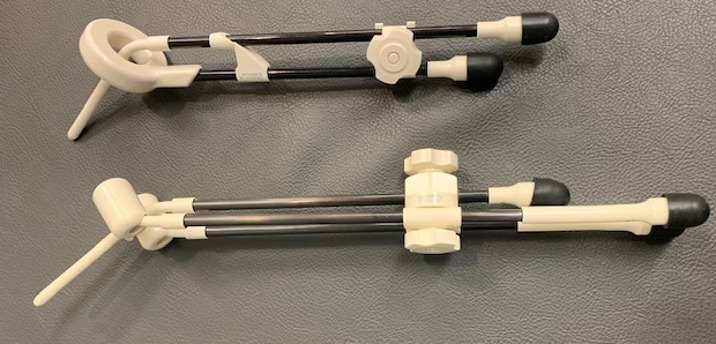Brachytherapy for Cervix Cancer

Brachytherapy is the critical part of radiation treatment for cervix cancer, when radiation is the primary choice of curative treatment.
The goal of radiation therapy is to deliver a curative dose of radiation to the cancer while limiting the dose, and therefore reducing the risk of complications, to normal surrounding organs such as the rectum, bowel and bladder.
Radiation therapy for cervix cancer involves both brachytherapy and external beam radiation therapy.
External beam radiation therapy (treatment delivered from outside the body) is used to treat a larger targeted area: the cervix cancer itself and potential areas of spread of the cancer into other tissues, such as the lymph nodes. Brachytherapy is a treatment that uses a very small source of radiation that is delivered directly into the tumour. This allows a high dose of radiation to be given to the tumour, while the normal organs situated close by receive a much lower dose. This increases the chances of cure, while reducing the risks of injury to normal tissues that are close to the tumour.
In some cases of early cervix cancer, brachytherapy alone may be curative.
Most centres in Australia use high dose rate brachytherapy, which delivers treatment in a very short period of time (minutes) and can be delivered whilst the patient is under an anaesthetic.
In contrast, low dose rate brachytherapy delivers treatment over a longer period of time, usually several days, usually requiring hospital admission and isolation.
Both high dose and low dose rate brachytherapy are equally effective in treating cervix cancer.
What is the procedure for treatment?
A dedicated brachytherapy team is involved in the procedure. This may consist of a radiation oncologist, surgeon, radiation therapist who specialise in brachytherapy, medical physicist, radiologist and anaesthetist.
The preparation for the procedure involves a clinical examination, blood tests and may involve imaging with an MRI. A “low residue” diet may be recommended a few days prior to the procedure. Sometimes a microlax enema is prescribed the day of or the evening prior to each brachytherapy treatment. As the procedure is usually done under the general anaesthetic, the patient will need to be fasted 6 hours before the procedure. Sometimes an anaesthetic is delivered by an injection into the back (spinal or epidural). This is given to block pain in the lower part of the body.
The procedure is usually done in a dedicated suite or in an operating room. It usually takes around 20-30 minutes. It involves inserting a urinary catheter into the bladder, dilating the cervix and placing hollow tubes into and next to the cervix and tumour ( “applicators”). Sometimes hollow needles are used. Usually an ultrasound is used to guide the placement of the applicators in the uterus. An x-ray may be taken to check the positioning of applicators/needles.
Below are examples of the types of applicators that can be used. There are many different kinds of applicators and the decision on which applicator is best suited is made by the treating radiation oncologist.
The position of the applicators is secured with material such as vaseline gauze placed in the vagina and sometimes stitches in the skin in the area are used to stop the applicators from moving.
After the placement the applicators and their position need to be checked before treatment can be commenced.
In some centres the patient will be woken after the applicators are inserted. After recovery from the anaesthetic, the patient undergoes a scan (CT or MRI). Images from the scan are used to calculate (plan) the treatment, so that the dose is precisely tailored to each patient’s individual tumour and body structures. The calculations are done using dedicated computers and programmes that precisely calculate the doses delivered to the tumour and the normal tissues. After the calculations are completed and checked, the patient is brought into the treatment room for treatment.
Other centres may combine the planning delivery of the treatment to happen whilst the patient is under the anaesthetic. The same checks described above, are required to make sure that the radiation is delivered safely and accurately.
When not in use, the radioactive source is housed in a shielded container. When the patient is ready to be treated, the radioactive source is programmed to move from the shielded container via cables, into the applicators and/or needles to deliver the treatment. Treatment usually takes around 20 mins using high dose rate brachytherapy.
When treatment is completed, the radioactive source is programmed to return into the shielded container. The patient will not feel the treatment being delivered.
If the next treatment is to be repeated the following day, the patient is kept in hospital overnight. During that time, the patient will need to lie on her back until the treatment is completed, after which the applicators are removed. The urinary catheter will also remain in place until the applicators are removed. Special stockings may be placed on both legs, to prevent a clot (thrombosis) developing. The patient may be aware of intermittent compressions of the legs by a machine, to help the blood circulation. Pain relief medications are given to keep the patient comfortable. These can be given orally or by injections.
In centres where the treatment is delivered routinely in the operating theatre, multiple visits (3-4 usually) are required to complete the planned course of brachytherapy. At each visit, the treatment may be delivered under an anaesthetic.
After completion of treatment, the stitch (if used), vaginal packing, applicators and urinary catheter are removed. It is unusual to require an anaesthetic for this. Sometimes additional pain medications are given just prior to the removal of the applicators. The doctor and nurse will check the area to make sure there is no bleeding. The analgesic drip or spinal/epidural anaesthetic is removed.
After the applicators are removed, as long as the patient is well, she may be discharged home that day or the following day.
Patients will be assessed to work out what is their risk of developing a clot and be asked to start various preventative treatments according to that risk. This may be an injection of anti-coagulation that is given under the skin, or simply wearing special stockings for a period of time.
The patient will be given instructions to contact the treating team if she has symptoms of bleeding, pain, burning sensation on passing urine or having to pass urine frequently. She will be given a follow-up appointment by the team.
Potential early side effects from brachytherapy
Risks of the procedure include:
- Risks from having an anaesthetic
- Chance of developing an infection
- Bleeding
- DVT (blood clot) as a result of lying in the same position for some hours
- Perforation – where the applicator is not in position in the centre of the uterus but goes out through the wall. Risk of this is small as the procedure is done under ultrasound guidance. If this happens the patient is usually not treated on the day, may be kept in hospital overnight and given antibiotics.
- Discomfort from having applicators in place. Resolves when applicators are removed.
Long term side effects post brachytherapy
- Bowel effects including changes in bowel and bleeding
- Urinary issues including bleeding
- Sexual dysfunction including pain with intercourse, dryness and narrowed vagina
Results of brachytherapy
Brachytherapy is a critical part of the treatment of cervix cancer where radiation therapy is the primary treatment. Brachytherapy, by enabling the delivery of a high dose of radiation therapy to the tumour, improves the cure rate of cervix cancer.
The treatment is more effective if it is completed within a certain period of time and the team will arrange the brachytherapy schedule accordingly.
Page last updated: 10/09/2020




